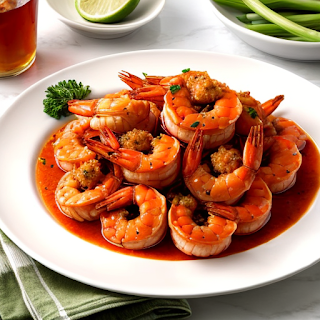Buffalo shrimp traces its origins to the iconic Buffalo wings, which were first created in Buffalo, New York, during the 1960s. The original Buffalo wings were invented by Teressa Bellissimo at the Anchor Bar, who tossed leftover chicken wings in a spicy sauce made of hot sauce and butter. This simple yet flavorful combination quickly gained popularity, becoming a staple in bars and restaurants across the United States.
Over time, the Buffalo sauce gained widespread acclaim, inspiring chefs and home cooks to experiment with various proteins beyond chicken wings. Thus, the Buffalo shrimp emerged as a delicious variation, offering a seafood twist to the beloved flavor profile of Buffalo sauce. Today, Buffalo shrimp is served in restaurants worldwide and is a popular appetizer or main dish for seafood lovers everywhere.
Ingredients for Buffalo Shrimp:
To prepare Buffalo shrimp, you'll need the following ingredients:
- 1 pound of large shrimp, peeled and deveined
- 1/2 cup of hot sauce (such as Frank's RedHot)
- 1/4 cup of unsalted butter, melted
- 1 tablespoon of white vinegar
- 1 teaspoon of garlic powder
- 1/2 teaspoon of paprika
- 1/4 teaspoon of cayenne pepper (adjust according to spice preference)
- Salt and black pepper to taste
- Vegetable oil for frying
- Optional: blue cheese dressing or ranch dressing for serving
- Celery sticks for garnish
Preparation Time:
- Preparation: 15 minutes
- Cooking: 10 minutes
- Total Time: 25 minutes
Instructions for Buffalo Shrimp:
Follow these simple steps to prepare delicious Buffalo shrimp:
1. Prepare the Buffalo Sauce:
- In a small saucepan, combine the hot sauce, melted butter, white vinegar, garlic powder, paprika, cayenne pepper, salt, and black pepper.
- Heat the sauce over medium heat, stirring occasionally, until the butter is melted and the ingredients are well combined. Remove from heat and set aside.
2. Fry the Shrimp:
- In a large skillet or deep fryer, heat vegetable oil to 350°F (175°C).
- Pat the shrimp dry with paper towels to remove excess moisture.
- Carefully add the shrimp to the hot oil in batches, ensuring not to overcrowd the skillet.
- Fry the shrimp for 2-3 minutes per side or until they are golden brown and cooked through.
- Once cooked, remove the shrimp from the oil using a slotted spoon and transfer them to a plate lined with paper towels to drain any excess oil.
3. Toss the Shrimp in Buffalo Sauce:
- In a large bowl, pour the prepared Buffalo sauce over the fried shrimp.
- Gently toss the shrimp in the sauce until they are evenly coated.
4. Serve and Enjoy:
- Transfer the Buffalo shrimp to a serving platter.
- Garnish with celery sticks and serve hot.
- Optionally, serve with blue cheese dressing or ranch dressing on the side for dipping.
5. Enjoy the Delicious Flavor:
- Serve the Buffalo shrimp as an appetizer at parties, game nights, or gatherings.
- Alternatively, enjoy them as a main dish with a side of rice, salad, or coleslaw.


Comments
Post a Comment
Thanks for your feedback